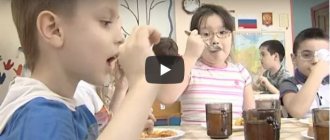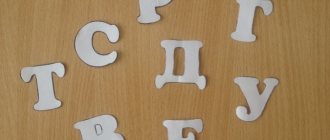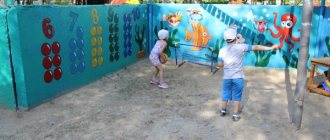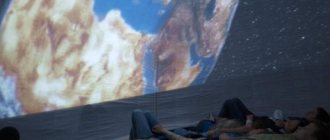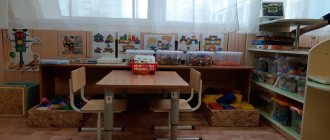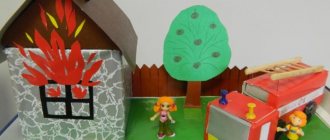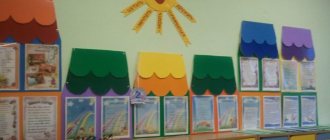- Where to begin?
- For boys
- Reception
Decorating a group room in a preschool institution for each teacher and parents becomes not just a responsibility, but also a creative process. It implements unique ideas and experiences, sometimes from several generations. In this article we will not only describe, but also place various corners in kindergarten in pictures. We hope that our site and this article will be useful to you. Well, let's get started.
Where to begin?
Before you start decorating a group in a kindergarten and creating various thematic corners in a kindergarten, you should definitely take care of the general decoration inside the group . When painting, you should not use a lot of bright colors. It is better if the tone of the main paint is light and “warm”:
- beige,
- peach,
- pearl and so on.
Photo wallpapers with characters from fairy tales and cartoons, as well as stickers with children's themes, look good in children's groups.
It is better to decorate all the group’s rooms in the same style and think in advance about a theme that will tie together the bedroom, reception area, study area and play corners in the kindergarten. Before you start designing specific corners, you should consult with your parents, discuss together and get acquainted with possible options for children of different ages. Here are some corners that can be organized in a kindergarten; for an example, see the photo.
Developmental environment
Play space
Traditionally, each group has a separate room for a bedroom, and the common group room is divided into an activity area and a play area. Play corners for kindergarten are designed differently depending on the age of the children in the group, free space and the creative scope of the organizer. For example, in the play area, a separate place is often allocated for a mummering corner in a kindergarten.
The location for it must be chosen with special care, it must be easily accessible and constantly open to children. The purpose of its design is to create conditions in the group for the creative activity of children, the development of imagination, the formation of gaming skills, the implementation of gaming plans, and the cultivation of friendly relationships between children. You can decorate such a place in the form of a model house, a stylist’s office, or a small screen with a variety of outfits:
- professions,
- animals,
- artists,
- fairy tale heroes and so on.
Once the location has been determined and the design option has been selected, you can begin the practical part. The boundaries of the corner are formed using furniture. This could be: a low rack with shelves, drawers and a crossbar for clothes hangers. For convenience, a table and chairs can be located in the corner. A mandatory attribute in the mummers' corner should be a mirror where children can examine and evaluate their appearance. You can paste pictures of various suits, hats and other items of clothing on the wall.
Design options
Sometimes a hairdresser’s corner in a kindergarten fits harmoniously into such a corner. Here everything is ready to equip the hairdresser’s workplace - a table, a chair for the client, a mirror. On the table you can put bottles, combs, hair decorations, etc. You can glue pictures of scissors and combs on the wall. The apron for the master can be located on one of the hangers on the crossbar.
If space allows, the hairdressing salon corner in the kindergarten is designed separately, as an independent area for the role-playing game “Barbershop”. First, the necessary furniture and shelves are also installed. Instead of a rack with outfits, you can place a bedside table or mini-wardrobe with hairdressing supplies. You can also sew wall pockets for them. Then game items are added. Usually such a place is made as a children's corner for a girl, based on an interest in hairstyles, jewelry, and so on.
Subject-based development environment in the junior group. Development corners
Shkilnaya Marina
Subject-based development environment in the junior group. Development corners
Subject development environment
Development corners
Junior group
Educator: Shkilnaya M.N.
Patriotic corner
The patriotic corner is equipped with symbols of the Russian Federation, a map of the Russian Federation, literature: about the village, Krasnoyarsk, Krasnoyarsk Territory, Moscow, historical literature. A collection of postcards about the sights of the Krasnoyarsk Territory has been collected.
Educational class=”aligncenter” width=”675″ height=”506″[/img]
The training center is equipped with: a magnetic board, a number series, geometric shapes.
Theater and music corners
In the center there are children's musical instruments (spoons, rattles, tambourines, drums, noise instruments. In the corner there are : a tape recorder, a microphone, a collection of audio recordings with music and fairy tales.
In the theater corner there is : a theater screen, a puppet theater, a finger theater, a table theater, a shadow theater, masks, and attributes for staging fairy tales.
Developmental corner
This center contains normative and symbolic material, sets of cards for comparing numbers and quantities, mosaics, puzzles, games for the development of fine motor skills , lacing, and magnetic alphabet.
In the process of forming mathematical concepts , games with household objects : corks, clothespins, ropes, buttons, beads. Small toys (Kinder Surprise)
used by children for counting. A set of geometric shapes is used to reinforce knowledge of shapes.
Educational board and printed games.
Book corner
The book corner is equipped with books appropriate for age and subject matter. Portraits of children's writers.
Creative corner
In corner there is material and equipment for artistic and creative activities: drawing, sculpting and applications: Paints, gouache, colored pencils, wax crayons, glue, napkins, felt-tip pens, stencils, coloring books, clay, plasticine, colored paper, cardboard, scissors ( figured, brushes. Didactic games, pictures, drawings depicting crafts, diagrams depicting the sequence of work.
For decorative creativity there are: sequins - various types, colored threads, fabric, beads, decorative decorations, etc.
For children's creativity we use: natural material, waste material.
Chalkboard for drawing.
Experimentation Corner
In the corner there is material for carrying out experimental activities for children: magnifying glasses, compasses, beakers, flasks, measuring cups, hourglasses, plastic containers. and many more etc.
For experimentation there are in the corner : soil, stones, shells, clay, sand, colored sand, seeds, cereals, natural materials.
A card index of experiments has been collected.
Corner of nature
This center contains various types of indoor plants, tools for caring for plants: aprons and sleeves, sticks for loosening, metal children's rakes and shovels, a spray bottle, watering cans, etc.
Passports with symbols have been issued for plants.
In the corner there are various didactic games of an environmental orientation, a series of paintings: Wild and domestic animals, birds. Designed layouts (wild animals, animals of hot countries, domestic animals)
An important component corner is the nature and weather calendar, where children make daily observations.
Corner of role-playing games
This center is located: “Hospital”
,
“Barbershop”
,
“Shop”
,
mummers corner . Equipment and aids are placed in such a way that children can easily select toys and combine them “to suit their creative play ideas
.
Corner of solitude
The corner is equipped with a table and chair and is separated by transparent curtains and a machine. In it, a child can retire, watch a book, play with his favorite toy, just relax or leave his bad mood.
Physical Activity Corner
In the corner there are : skittles, masks for outdoor games, balls, ribbons, handkerchiefs, rings, hoops and skipping ropes.
Design Corner
The corner presents various types and forms of construction sets: large and small, plastic, soft, wooden, various machines.
Safety corner
Reflects safety on the street (traffic rules)
and fire safety. A specially equipped table with road markings and an additional set of small cars and road signs serves as a teaching aid.
In this corner there is a garage for cars.
Thank you for your attention.
For boys
However, there must be a place for boys to play in the play area. A children's corner for a boy may take up a little more space than for a girl. The main requirements for its location also remain convenience and accessibility for children. Such corners are created to take into account the gaming interests of children of different sexes, their differentiation and the development of gaming activities in general.
Design options are chosen based on the interests of the majority of boys in the group and general “boy” themes. For example:
- car showroom,
- nautical theme (ship),
- workshop,
- military base,
- or a corner of space in kindergarten.
Outer space will be interesting and useful for children of senior preschool age. With its help, children will gain basic knowledge about space, planets, and spaceships in a playful way.
The color scheme of such a corner is determined by the theme.
These are the shades:
- blue,
- purple,
- white and yellow colors.
It would be good if the furniture for the corner was made in the same colors. If the group’s budget does not allow you to buy new furniture, you can use self-adhesive film of the desired color and texture. On the floor you can place a rug with a space theme (lunar surface, meteorite). A simple model of the solar system must be present - either as a poster on the wall, or paper planets in volumetric form, hanging from the ceiling.
Color solution
Reception
The locker room or reception area is the first thing a child and his parents see when they bring their child to kindergarten. Therefore, its design must be taken seriously. For children, there is usually a mood corner in kindergarten. The purpose of such a corner is to create a favorable emotional environment in the group. Thanks to it, children learn to understand not only their own mood, but also the mood of their peers.
In the design of such a corner, ready-made stands or home-made models can be used. The principle of their design is the same: in several pockets there are pictures with different emotions (their number depends on the age of the children), pockets for photographs of children are attached to the bottom. Coming to the group, the child, together with a parent or teacher, determines his mood and places his photo in the pocket under the corresponding emotion.
If the mood changes during the day, the photo is rearranged. Emotions can be depicted in the form of emoticons and cartoon characters. An approximate list in the older group could be: joy, fun, calm, surprise, sadness, anger.
note
It’s worth paying attention to the corner of the menu in kindergarten. The purpose of its creation is to familiarize parents with the child’s diet outside the home, as well as the basic principles of nutrition for preschool children. We can decorate it as a ready-made stand or manually (with painted pictures on the theme of the group, in the form of three-dimensional figures made of salt dough). Usually it has several pocket compartments. They contain a daily menu, as well as rules for feeding children.
Find out how to make a children's playground out of logs with your own hands in our material! You will learn how to properly make clothes for children in our article!
At https://karuselkin.ru/sad-i-shkola/kak-organizovat-i-provesti-detskij-novogodnij-utrennik/ link you will find interesting scenarios for the New Year.
If entering kindergarten is not an urgent problem, and you are just preparing to become parents, then you can beautifully decorate the room for your child by organizing children's corners for newborns. Usually they provide a sleeping place for the baby, a changing place and a place for clothes and toys. The colors of furniture and wallpaper should also be chosen soothing and light. You can paste a few funny pictures of children's toys. Soft toys are excluded in such a corner. So, the options for children's corners can be varied, the main thing is that they are aesthetically designed, safe and interesting for children.
Experimentation corner in kindergarten
Little “whys” ask a huge number of questions every day. They are interested in absolutely everything: why it rains, why the wind blows, why the sun shines... Explaining to a small child in an accessible form the essence of natural phenomena and patterns, talking about the causes and consequences of what is happening is not an easy task. Of course, you can try to tell or show, or you can conduct an experiment. This is exactly what kids do in kindergartens in the so-called experimentation corner.
Contents and design of the experimentation corner in kindergarten and other preschool educational institutions
Popular wisdom says: “it’s better to see once than to hear a hundred times.” That is why children's experimentation is of great importance in the development of preschoolers. Experimental activities broaden your horizons, teach you to establish cause-and-effect relationships, awaken curiosity, teach you to observe, reflect and draw conclusions, and also follow safety rules.
To design the experimentation corner, various materials and devices are used, namely:
- natural materials, such as: sand, sawdust, stones, shells, cones, acorns, dry leaves;
- some food products, for example, salt, sugar, flour, cereals, and plant seeds;
- thematic manuals, educational books;
- instruments for conducting experiments. Depending on the age of the children, the following are used: test tubes, magnets, magnifying glasses, microscopes, scales, syringes without needles, pipettes, wooden sticks, rubber bulbs, rulers and measuring tapes;
- also colored paper, cardboard, scissors, fabrics, leather scraps, fur;
- rubber toys, containers for storing various bulk and non-bulk materials used to decorate the experimentation corner, etc.;
- food coloring, gouache;
- For older children, diagrams and tables with algorithms for conducting experiments are placed in the corner.
In addition to the material base, it is very important to properly arrange the experimentation area in the preschool educational institution. Thus, a place should be allocated for instruments, educational literature, an observation diary, conducting experiments, and storing materials.
Other requirements must also be taken into account during the registration process. For example, when selecting equipment for an experimentation corner in a preschool educational institution, it is necessary to take into account the level of development and age of the children. In addition, safety measures and sanitary standards must be observed, and each child is familiar with the rules of behavior and the procedure for conducting the experiment.
